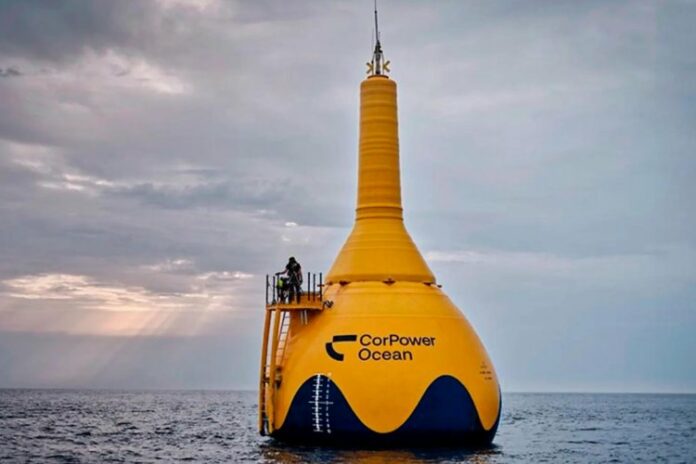In a mechanical sense, this is a pretty standard looking anchored buoy point absorber type system; waves lift a floaty air-filled chassis up and down, and a power takeoff system within harvests energy by converting that linear up and down movement into rotation for running generators.
CorPower says it’s a novel phase control technology called WaveSpring that sets its huge C4 buoys apart. An internal pneumatic cylinder is pre-tensioned to pull the buoy downwards, such that in the absence of active control, the buoy simply sits still in “transparent” mode no matter how high the waves get. This acts as a safety mechanism under the worst conditions.
But when waves are more reasonable, things get weird and the C4 starts bobbing up and down twice as far as the amplitude of the waves, by adjusting the phase of its movements. That is, it doesn’t rise at the exact same time as the wave does, it lags behind to get a little extra energy boost, which propels it higher.
The effect makes a huge difference to power generation; CorPower claims a 300% increase in power generation compared to a similar buoy without Wavespring phase adjustments.
It’s also remarkable to watch, as you can see at around 0:45 in the video below – particularly given that these buoys are so dang big – 19 m (62 ft) tall and 9m (30 ft) in diameter.
CorPower has just hauled this C4 in after six months at an exposed test site in the Atlantic ocean off Aguçadoura, Portugal, where it’s been connected to the grid and exporting power. In November, the weather treated CorPower to the perfect survivability test, delivering monster 18.5-m (61-ft) waves – higher than any previously measured. The C4 went into “transparent” mode and rode out the storm without issue.
The team recorded a peak power export around 600 kW, but says the device was limited in both velocity and stroke during the test. It expects to see peak output around 850 kW when it’s run at full capacity.
Running test data against the C4’s digital twin, CorPower engineers discovered they’d been slightly underestimating its power generation capabilities, so things are definitely on track there.
Now, the buoy is getting a planned checkup back on dry land, where it’ll be studied to see how it’s held up at sea, and upgrades and adjustments will be made before it’s towed back to its site. That’s one clear benefit of this kind of design; you can very easily hook and unhook these machines for maintenance back at port.
Getting down to tin tacks, CorPower has projected a Levelized Cost of Energy (LCoE) in the range of US$33-44 per megawatt-hour once it’s deployed 20 gigawatts of capacity. That would be a pretty competitive price, given that wave energy is pretty much 24/7 and can fill in the gaps when wind and solar aren’t delivering.
20 GW is a whole lotta buoys though. More than 20,000 of them. So it’ll take a while to get that LCoE down to a manageable level. Next step, says the company, will be a multi-buoy site where the concept can start to be tested in something closer to a commercial rollout.
Source: New Atlas



